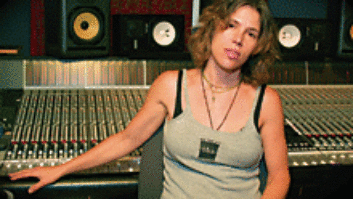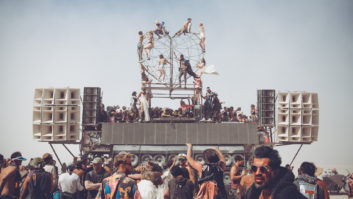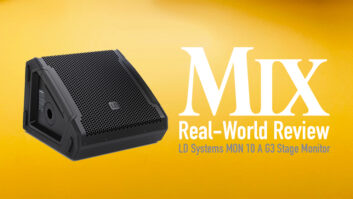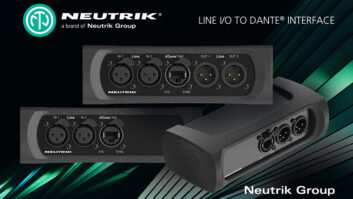Studio A measures 25×22 feet with 14-foot ceilings and also includes an amp locker and an iso booth measuring 12×8 feet. This summer, the iconic brand, Converse, decided to open a top-flight recording studio in Williamsburg, Brooklyn: Rubber Tracks. The studio, which has already seen dozens of bands and musicians pass through from Brooklyn and beyond, features an “A” list of equipment from leading audio manufacturers as well as a team of highly experienced engineers. What makes the studio different besides its great location, talented staff, outstanding gear and great acoustics? That one’s easy: It offers the studio at no cost to the musician.

At first glance, the concept seems very puzzling indeed, but when you consider how many bands were formed by kids wearing Converse All-Stars, how many aspiring musicians wore black Converse hi-tops (myself included) and how ingrained the Converse brand is in youth culture, the picture becomes clearer. “By opening Converse Rubber Tracks, it’s a way for us to say thank you to musicians all over who have helped us become the brand we are and to provide a place for new artists to have access to resources they may not be able to afford,” said Geoff Cottrill, chief marketing officer, Converse. “This is our way to invest in the future of music, and we couldn’t be more excited about it.”
The centerpiece in Studio A’s control room is
an API 1608 console.Pounding the Pavement in Williamsburg

While musicians have to go through an online application process to become eligible, the studio is open to bands and artists of every genre. “Converse wanted diversity,” says studio manager Brad Worrell. “There are a lot of garage bands around here, but we didn’t want just rock ’n’ roll coming through the studio. Also, we want to attract bands who will really benefit from this experience, not just straight-up hobbyists or people who do music just on occasion.”
Worrell says that the talent cauldron of Williamsburg was a conscious decision because they wanted to be planted into the middle of the music scene as much as possible. “Initially, we were looking at locations on the Lower East Side of Manhattan, but building it out here was a really smart move. It is very convenient, and there is so much music here.”
In its past life, Rubber Tracks was a 5,000-square-foot dry-cleaning business before Converse recruited New York-based architecture firm A+I Design to reshape the facility. According to Worrell, NY-based contractor Chris Harmaty and his company, Audio Structures, played a key role in helping the room achieve its sound: “He really came through on many different levels,” says Worrell. “The real meat and potatoes got covered, and we ended up with a wonderful space. Every engineer that has been through here has been very impressed with the sound of the live room.”
From the earliest iterations of the concept, the Converse team wanted Rubber Tracks to be truly multipurpose able to accommodate any music style, and also double as a rehearsal space if needed. For Studio A, which measures 25×22 feet with 14-foot ceilings and includes an amp locker and an iso booth measuring 12×8 feet, Harmaty designed movable panels to help artists gain more control over the sound that they are looking for. The live room also features barn-weathered hardwood floors, which not only adds to the aesthetic character of the room, but also sounds great.
With A Little Help From My Friends
Rubber Tracks was outfitted with gear from GC Pro and Guitar Center, including an Allen Sidesdesigned, large-format Ocean Way HR2 monitoring system, which the owners claim is the only one in New York City. Other gear Guitar Center provided includes a variety of amplifiers and electric guitars, as well as percussion and other instruments. “Many of these artists are coming into the studio for the very first time, and might not have top-of-the-line gear, so it’s great to be able to offer such a great assortment to them,” observes Worrell.
The centerpiece in Studio A’s control room is an API 1608 console, which is economically sized yet emanates a large sound. “We knew we wanted an analog desk, and I didn’t think any sort of automation was going to be necessary, realizing that a lot of that was going to be done in the box,” says Worrell. “Also, artists that come through here are probably going to want to do some more work [later] on with their mixes, so we didn’t need any kind of built-in automation.” Some of the key outboard gear present at Rubber Tracks includes Empirical Labs Distressors a full complement of Universal Audio compressors (LA3A, LA2A and 1176), as well as equipment from Neve, Drawmer and Lexicon.
Studio B, which is snug at just 10×17 feet, serves as Rubber Track’s video-editing suite. Its main raison d’être is to document the day-to-day studio happenings for Converse’s website, but Worrell says it is well on its way to becoming a second audio production room. “It will be soundproofed, and we’ll have Pro Tools in there. We want to bring it up to the point where it can also be a small mix room.”
In addition to the technical areas, there is a large lounge area/performance space with a stage, complete backline and a QSC line array that can be used for DJs and bands. In addition, there is also a dedicated rehearsal. Each room is outfitted with tie lines so audio can be captured and multitracked from any combination of rooms.
While flexibility is key at Rubber Tracks, so is speed: “The turnover here has been pretty fast. We’re pumping bands through in one or two days,” Worrell points out. “The goal of the whole program is to give as many bands as possible chance to lay down some good tracks, so we often have four to five bands a week coming through here.”
Despite the frenetic pace and extreme variety of music, artists recording at Rubber Tracks has made a positive impression on Worrell so far: “My initial expectations were that I would only really like about 10 percent of the bands coming through here but in reality, it’s been more like 80 percent.”
Converse Rubber Tracks
Jeff Touzeau is a regular contributor to Pro Sound News and author of five published audio titles including Making Tracks: Unique Recording Studio Environments (Schiffer).




